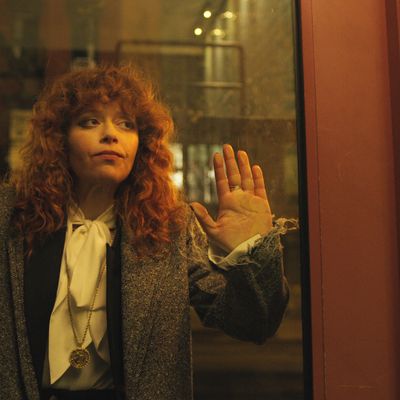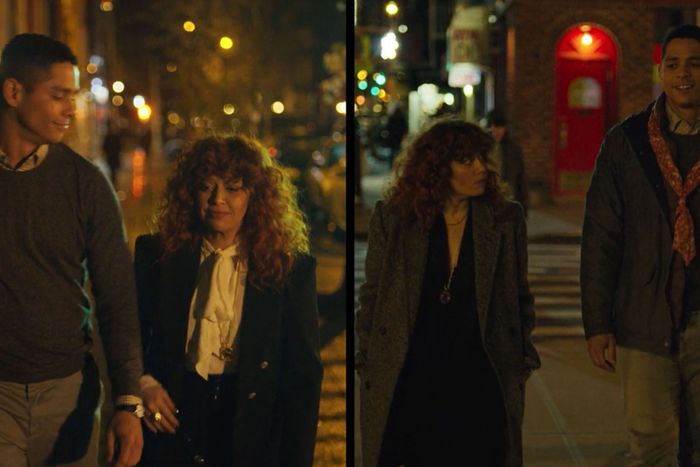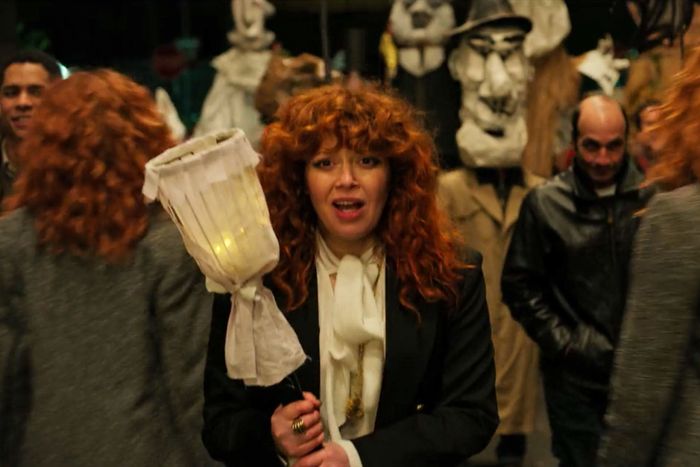
In the final episodes of Netflix’s Russian Doll, the world starts falling apart. Caught in time loops that reset every time they die, Nadia (Natasha Lyonne) and Alan (Charlie Barnett) realize that people are disappearing from existence, the world is growing less stable, and they have no choice but to finally confront their buried traumas and the fear that they’re fundamentally unlovable. Alan has to forgive his girlfriend, Beatrice (Dascha Polanco), and accept his own role in their unhappiness. Nadia must admit that she blames herself for her mother’s death, and figure out whether she even wants to live past her 36th birthday.
Then Nadia and Alan die one more time, and Russian Doll’s final twist is revealed: When we reach the season finale, the Nadia and Alan we’ve been following from the beginning are no longer in the same universe. They’ve been split into two separate timelines, each of them newly charged with a sense of purpose and a desire to live. But they can’t celebrate together. Instead, they’re paired with the past versions of each other: The self-actualized Alan has to shake the original Nadia out of her destructive, sublimated death wish, and the newly self-accepting Nadia has to convince the original, self-loathing Alan not to kill himself.
Watching the healed versions of Alan and Nadia try to coax the unknowing, earlier iterations of each other toward self-acceptance is heartbreaking. For the first few episodes of the series, the scariest thing about Nadia’s recurring deaths and rebirths is that she’s going through them alone. The midseason discovery that Alan is also looping, that the two of them are tied to one another somehow, and that they no longer have to face the dread of existential limbo in total isolation, is the key to the series. It’s the moment Russian Doll becomes supercharged, turning from a well-made show into something with momentum and depth. Whatever she may want to believe, Nadia cannot escape her own self-hatred without connecting with someone else. The same goes for Alan, although in his case, he’s put entirely too much of his sense of self onto someone else, and can’t extricate his failed romantic life from his sense of self-worth (or lack thereof). Alan and Nadia both need to rebalance how they see themselves in the world. They must examine how much they rely on themselves rather than other people, which also means making the conscious decision that, yes, they do want to keep living. They do it together, through the insight they each get from thinking about someone else.
In the seventh episode, titled “The Way Out,” the time loops are rapidly erasing the world around Nadia and Alan, turning their personal limbo into an apocalyptic crisis. At the peak of this emptying-out, Nadia walks out of the bathroom and finds her birthday party eerily vacant; only her friend Maxine is left, dancing dreamily by herself. Extinction looms, and so Alan and Nadia are forced to confront everything they’ve been avoiding: Alan forgives Beatrice; Nadia talks to Ruth about her guilt over her mother’s death and passes her beloved book, her childhood life preserver, to another young girl. As she’s dying for the final time — before the final time, that is — Nadia’s young self appears before her and whispers, “She’s still inside you.” It’s a line that encompasses Nadia’s belief that all of their loops somehow exist at the same time, and also Ruth’s question about whether, somewhere inside Nadia, there’s still a young girl who desperately wants to live. It also evokes the series’ title image of nesting dolls. It feels like an ending, like Alan and Nadia have fixed everything at last. This is why it’s so excruciating when, in the final episode, Nadia and Alan’s timelines split. When, at last, they walk into the deli to greet one another, we realize they’ve healed themselves but no longer have each other. It’s a huge loss.
Russian Doll’s last episode is called “Ariadne.” In Greek myth, Ariadne stands watch over an impossible labyrinth with a monster inside, and she saves the man she loves by giving him a sword to fight the monster and a ball of string so he can find his way out of the maze. Nadia and Alan’s final task is to help each other out of the maze. It’s a test of whether they’ve grown enough to withstand the loneliness of doing it by themselves, and whether they have learned enough about one another to do it at all.
It’s an opportunity for Russian Doll to weave back through small moments from the previous episodes, offering little bits of evidence that Alan and Nadia do understand one another. Alan’s problems were always a bit simpler, more tied to the present. After sticking with him in his post-Beatrice tailspin, and soothing him to sleep with a bedtime story about “a broken man and a lady with a death wish,” all Nadia really has to do to dissuade Alan from jumping off the roof is reassure him. “You promise if I don’t jump, I’ll be happy?” he asks her. “Absolutely not,” Nadia says, “but I can promise you that you will not be alone.” This is enough for him.
Nadia is a harder nut to crack. She’s lying to herself about how much she needs help, and her self-hatred is both deeply rooted and well-disguised. Alan manages to jolt her by first asking the deli guy to call Nadia and tell her that she owes Alan $152,780.86 — it’s a callback to episode five, when Nadia tells Alan about her family’s history in the Holocaust, about the large stash of gold bullion they purchased because they couldn’t trust banks, and about how her mother sold off all but one of the coins intended for Nadia’s college fund. (If she still had that gold bullion today, she reveals to Alan, it’d be worth exactly $152,780.86.) Then, when Alan gets Nadia downstairs and listening, he tells her he knows where Oatmeal is.
Nadia’s worry over her semi-feral deli cat is her ongoing obsession from the first moments of the series. From the start, Nadia has displaced her feelings about everything onto Oatmeal. If all Nadia needed to do to get through to the original, benighted Alan was to tell him he’s not alone, all Alan needs to do is demonstrate the same thing by going out to look for her cat. Nadia’s outer shell, her shiny, smiling exterior nesting doll, is extremely hard to get past, though, so Alan also has to actually save her life by pulling her away from a speeding cab that nearly runs her over — the same cab that kills her in the first episode. At last, she gets the message: Going home with Mike (Jeremy Lowell Bobb) is the path to destruction, so she turns her back on him and walks toward Alan, who truly seems to know her. Maybe she’s beginning to remember the earlier timelines, or maybe she’s just finally convinced that Alan cares for her, and deserves her trust in return.
These stories are woven throughout Russian Doll’s season finale, and the show gives us our own version of Ariadne’s string to help navigate the maze. As Nadia and Alan are split up into separate timelines, they get identifying costume markers so we can keep track of who’s who: the Nadia who remembers everything wears a white blouse, eye-catching and distinct from her usual black wardrobe. Meanwhile, at Nadia’s birthday party, a partygoer wraps a red scarf around the Alan who remembers everything, clearly distinguishing him from the suicidal Alan in the other timeline. For most of the episode, these markers serve as instant visual cues helping to distinguish which story we’re watching.
Then, in the very last moments of the finale, the two timelines run in parallel. Each Alan and Nadia pair succeeds in swerving away from self-destruction, and they both walk into a tunnel where a parade is forming, led by Horse (Brendan Sexton III), the homeless man who lives in Tompkins Square Park. It’s a surreal, raucous, otherworldly scene: Horse wears a giant horse head, while other people in the parade wear masks or carry enormous grotesque faces held high on sticks. Both Alan and Nadia pairs walk into the middle of the parade, and when they walk out on the other side, the timelines have joined again. Nadia is wearing a white blouse and Alan has a red scarf around his neck; they are the characters we’ve followed this whole time, and in the end, they make it through together.
It is an amazingly sweet ending for a series that so often bristles with pain and fear. But the parade also has one more hidden secret. When the timelines merge, and our eye follows Nadia into the fray of the parade, you can see two more Nadias walking past her on each side of the frame, both dressed in the heather-gray coats of the Nadia who doesn’t remember. Earlier, Nadia told Alan that “life is like a box of timelines,” an idea she has in part because she’s being haunted by a ghostly, child version of herself. Nadia believes the ghost isn’t just a vision; it’s a version of herself that still exists somewhere, trapped in time.
The multiple Nadias in the parade imply that more than one alternate timeline exists. As she herself suspected, there are many nested iterations of Nadia, and at the end, she accepts not just the child version of herself but every other person she’s been in between. She reaches outside herself enough to trust someone else, and to want to save him. The last time we see him, Alan is triumphant, roaring, and there’s a massive smile on his face. Nadia has had to tear down and reconsider much more of herself, and she does not smile. But she marches forward anyhow, resolute and overcome and whole.




